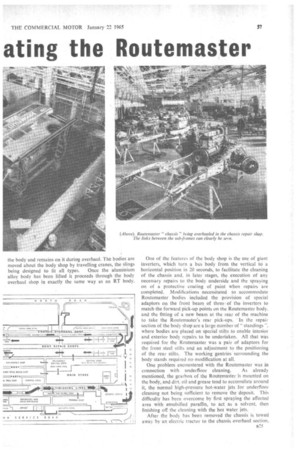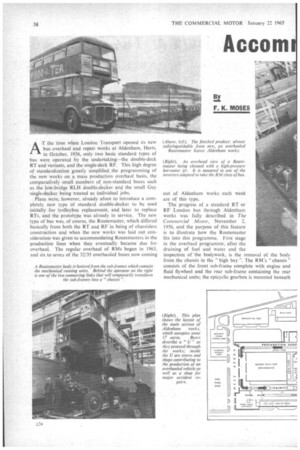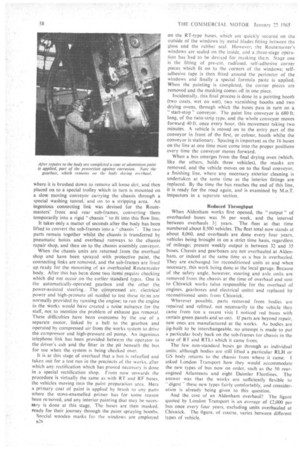ating the Routemaster
Page 59

Page 58

Page 60

If you've noticed an error in this article please click here to report it so we can fix it.
AT the time when London Transport opened its new bus overhaul and repair works at Aldenham, Herts, in October, 1956, only two basic standard types of bus were operated by the undertaking—the double-deck RT and variants, and the single-deck RF. This high degree of standardization greatly simplified, the programming of the new works on a mass production overhaul basis, the comparatively small numbers of non-standard buses such as the low-bridge RLH double-decker and the small Guy single-decker being treated as individual jobs.
Plans were, however, already afoot to introduce a completely new type of standard double-decker to be used initially for trolleybus replacement, and later to replace RTs, and the prototype was already in service. The new type of bus was, of course, the Routemaster, which differed basically from both the RT and RF in being of chassisless construction and when the new works was laid out consideration was given to accommodating Routemasters in the production lines when they eventually became due for overhaul. The regular overhaul of RiMs began in 1963, and six to seven of the 32/35 overhauled buses now coming out of Aldenham works each week are of thistype.
The progress of a standard RT or RF London bus through Aldenham works was fully described in The Commercial Motor, November 2, 1956, and the purpose of this feature is to illustrate how the Routemaster fits into this programme. First stage in the overhaul programme, after the draining of fuel and water and the inspection of -the bodywork, is the removal of the body from the chassis in the "high bay ". The RM's " chassis " consists of the front sub-frame complete with engine and fluid flywheel and the rear sub-frame containing the rear mechanical units; the epicyclic gearbox is mounted beneath
the body and remains on it durirrg overhaul. The bodies are moved about the body shop by travelling cranes, the slings being designed to fit all types. Once the aluminium alloy body has been lifted it proceeds through the body overhaul shop in exactly the same way as an RT body. One of the features of the body shop is the use of giant inverters, which turn a bus body from the vertical to a horizontal position in 20 seconds, to facilitate the cleaning of the chassis and, in later stages, the execution of any necessary repairs to the body underside and the spraying on of a protective coating of paint when repairs are completed. Modifications necessitated to accommodate Routemaster bodies included the provision of special adaptors on the front beam of three of the inverters to match the forward pick-up points on the Routemaster body, and the fitting of a new beam at the rear of the machine to take the Routemaster's rear pick-ups. In the repair section of the body shop are a large number of " standings where bodies are placed on special stilts to enable inteolor and exterior body repairs to be undertaken. All that was required for the Routemaster was a pair of adaptors for the front steel stilts and an adjustment to the positioning of the rear stilts. The working gantries surrounding the body stands required no modification at. all.
One problem encountered with the Routemaster was in connection with underfloor cleaning. As already mentioned, the gearbox of the Routemaster is mounted on the body, and dirt, oil and grease tend to accumulate around it, the normal high-pressure hot-water jets for underfloor cleaning not being sufficient to remove the deposit, This difficulty has been overcome by first spraying the affected area with emulsified paraffin, to act as a solvent, then finishing off the cleaning with the hot water jets. • After the body has been removed the chassis is towed away by an electric tractor to the chassis overhaul section. B75 where it is brushed down to remove all loose dirt, and then placed on to a special trolley which in turn is mounted on a slow moving conveyor carrying the chassis through a special washing tunnel, and on to a stripping area. An ingenious connecting link was devised for the Routemasters' front and rear sub-frames, converting them temporarily into a rigid "chassis" to fit into this flow line.
It takes only a matter of seconds after the body has been lifted to convert the sub-frames into a chassis ". The two parts remain together whilst the chassis is transferred by pneumatic hoists and overhead runways to the chassis repair shop, and then on to the chassis assembly conveyor.
When the chassis units are returned from the overhaul shop and have been sprayed with protective paint, the connecting links are removed, and the sub-frames are lined up ready for the mounting of an overhauled Routernaster body. After this has been done two items require checking which did not occur on the earlier standard types. One is the automatically-operated gearbox and the other the power-assisted steering.. The compressed air, electrical power and high-pressure oil needed to test these items are normally provided by running the engine; to run the engine in the works would have created a noise nuisance for the staff, not to mention the problem of exhaust gas removal. These difficulties have been overcome by the use of a separate motor, linked by a belt to the gearbox and operated by compressed air from the works system to drive the compressor and high-pressure oil pump. An ingenious telephone link has been provided between the operator in the driver's cab and the fitter in the pit beneath the bus for use when the system is being checked over.
It is at this stage of overhaul that a bus is refuelled and taken out for a test run in the precincts of the works, after which any rectification which has proved necessary is done in a special rectification shop. From now onwards the procedure is virtually the same as with RT and RF buses. the vehicles moving into the paint preparation area. Here a primary coat of paint is applied by brush to any parts where the stove-enamelled primer has for sonic reason been removed, and any interior painting that may be necessary is done at this stage, The buses are then masked, ready for their journey through the paint spraying booths.
Special wooden masks for the windows are employed R26 on the RT-type buses, which are quickly secured on the outside of the windows by metal blades fitting between the glass and the rubber seal. However, the Routemaster's windows are sealed on the inside, and a ,three-stage operation has had to be devised for masking them. Stage one is the fitting of pre-cut, rachused, self-adhesive corner pieces which Et on to the corners of the windows; selfadhesive tape is then fitted around the perimeter of the windows and finally a special formula paste is applied. When the painting is completed, the corner pieces are removed and the masking comes off in one piece.
Incidentally, this final process is done in a painting booth (two coats, wet on wet), two varnishing booths and two drying ovens, through which the buses pass in turn on a " start-stop " conveyor. The paint line conveyor is 680 ft. long, of the twin-strip type, and the whole conveyor moves forward 40 ft. once every hour, this movement taking two minutes. A vehicle is moved on to the entry part of the conveyor in front of the first, or colour, booth whilst the conveyor is stationary. Spacing is important as the 16 buses on the line at one time must come into the proper positions every time the conveyor moves forward.
When a bus emerges from the final drying oven (which, like the others, holds three vehicles), the masks are removed, and the vehicle moves on to the final conveyor, a finishing line, where any necessary exterior cleaning is undertaken at the same time as the interior fittings are replaced. By the time the bus reaches the end of this line, it is ready for the road again, and is examined by M.o.T. inspectors in a separate section.
Reduced Throughput
When Aldenham works first opened, the " output " of overhauled I buses was 56 per week, and the interval between overhauls Y, years. The fleet at that time numbered about 8,500 vehicles. The fleet total now stands at about 8,060, and overhauls are done every four years, vehicles being brought in on a strict time basis, regardless of mileage; present weekly output is between 32 and 35 buses. Chassis and gearboxes are not overhauled at Aldenham, or indeed at the same time as a bus is overhauled. They are exchanged for reconditioned units as and when necessary. this work being done at the local garage. Because of the safety angle, however, steering and axle units are removed from the chassis at the time of overhaul and sent to Chiswick works (also responsible for the overhaul of engines, gearboxes and electrical units) and replaced by reconditioned units from Chiswick.
Wherever possible, parts removed from bodies are repaired and refitted, not necessarily to the vehicle they came from (on a recent visit I noticed red buses with certain green panels and so on). If parts are beyond repair, new ones are manufactured at the works. As bodies are jig-built to be interchangeable, no attempt is made to put a particular body back on the sub-frames (or chassis in the case of RT and RTL) which it came from.
Thefew non-standard buses go through as individual units: although bodies are still lifted a particular R1_,H or GS body returns to the chassis from where it came. I asked London Transport how they would accommodate the new types of bus now on order, such as the 50 rearengined Atlanteans and eight Daimler Fleetlines. The answer was that the works are sufficiently flexible to "digest these new types fairly comfortably, and consideration is already being given to this question.
And the cost of an Aldenham overhaul? The figure quoted by London Transport is an average of £2,000 per bus once every four years, excluding units overhauled at Chiswick. The figure, of course, varies between different types of vehicle.




















































































































